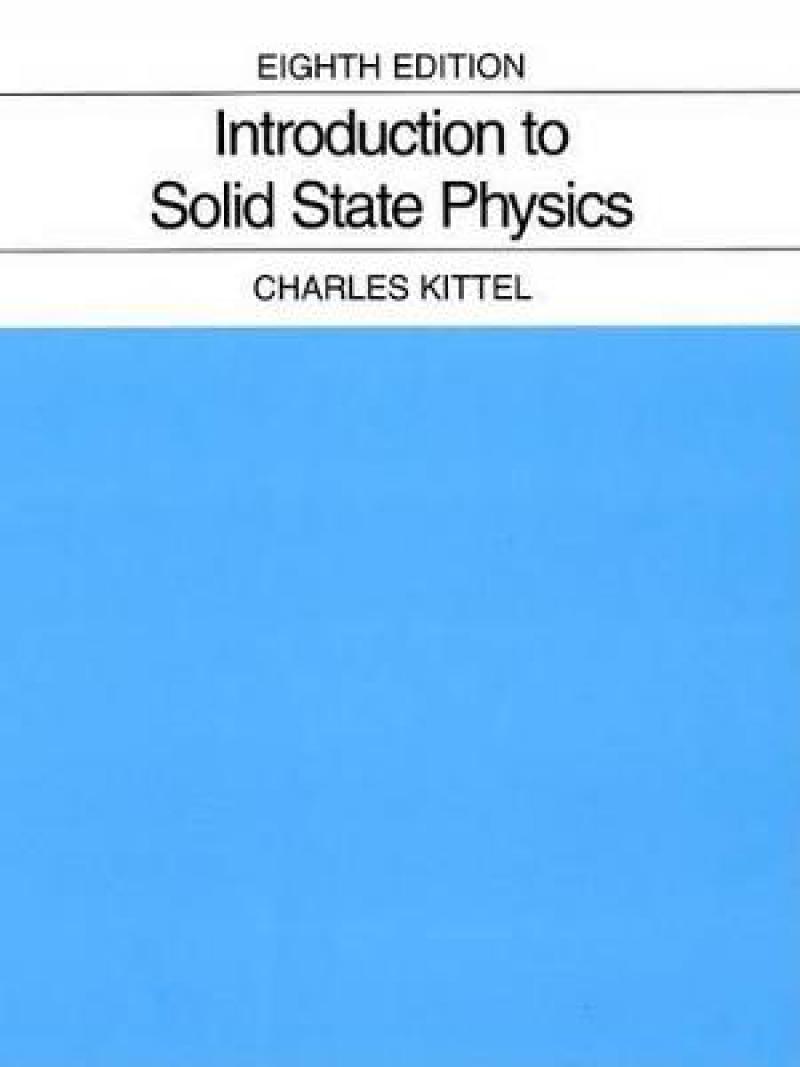Since the publication of the first edition over 50 years ago, Introduction to Solid State Physics has been the standard solid state physics text for physics students. The author's goal from the beginning has been to write a book that is accessible to undergraduates and consistently teachable. The emphasis in the book has always been on physics rather than formal mathematics. With each new edition, the author has attempted to add important new developments in the field without sacrificing the book's accessibility and teachability. A very important chapter on nanophysics has been written by an active worker in the field. This field is the liveliest addition to solid state science during the past ten years The text uses the simplifications made possible by the wide availability of computer technology. Searches using keywords on a search engine (such as Google) easily generate many fresh and useful references
Les mer
Since the publication of the first edition over 50 years ago, Introduction to Solid State Physics has been the standard solid state physics text for physics students. The author's goal from the beginning has been to write a book that is accessible to undergraduates and consistently teachable.
Les mer
CHAPTER 1: CRYSTAL STRUCTURE. Periodic Array of Atoms. Fundamental Types of Lattices. Index System for Crystal Planes. Simple Crystal Structures. Direct Imaging of Atomic Structure. Nonideal Crystal Structures. Crystal Structure Data. CHAPTER 2: WAVE DIFFRACTION AND THE RECIPROCAL LATTICE. Diffraction of Waves by Crystals. Scattered Wave Amplitude. Brillouin Zones. Fourier Analysis of the Basis. CHAPTER 3: CRYSTAL BINDING AND ELASTIC CONSTANTS. Crystals of Inert Gases. Ionic Crystals. Covalent Crystals. Metals. Hydrogen Bonds. Atomic Radii. Analysis of Elastic Strains. Elastic Compliance and Stiffness Constants. Elastic Waves in Cubic Crystals. CHAPTER 4: PHONONS I. CRYSTAL VIBRATIONS. Vibrations of Crystals with Monatomic Basis. Two Atoms per Primitive Basis. Quantization of Elastic Waves. Phonon Momentum. Inelastic Scattering by Phonons. CHAPTER 5: PHONONS II. THERMAL PROPERTIES. Phonon Heat Capacity. Anharmonic Crystal Interactions. Thermal Conductivity. CHAPTER 6: FREE ELECTRON FERMI GAS. Energy Levels in One Dimension. Effect of Temperature on the Fermi-Dirac Distribution. Free Electron Gas in Three Dimensions. Heat Capacity of the Electron Gas. Electrical Conductivity and Ohm's Law. Motion in Magnetic Fields. Thermal Conductivity of Metals. CHAPTER 7: ENERGY BANDS. Nearly Free Electron Model. Bloch Functions. Kronig-Penney Model. Wave Equation of Electron in a Periodic Potential. Number of Orbitals in a Band. CHAPTER 8: SEMICONDUCTOR CRYSTALS. Band Gap. Equations of Motion. Intrinsic Carrier Concentration. Impurity Conductivity. Thermoelectric Effects. Semimetals. Superlattices. CHAPTER 9: FERMI SURFACES AND METALS. Construction of Fermi Surfaces. Electron Orbits, Hole Orbits, and Open Orbits. Calculation of Energy Bands. Experimental Methods in Fermi Surface Studies. CHAPTER 10: SUPERCONDUCTIVITY. Experimental Survey. Theoretical Survey. High-Temperature Superconductors. CHAPTER 11: DIAMAGNETISM AND PARAMAGNETISM. Langevin Diamagnetism Equation. Quantum Theory of Diamagnetism of Mononuclear Systems. Paramagnetism. Quantum Theory of Paramagnetism. Cooling by Isentropic Demagnetization. Paramagnetic Susceptibility of Conduction Electrons. CHAPTER 12: FERROMAGNETISM AND ANTIFERROMAGNETISM. Ferromagnetic Order. Magnons. Neutron Magnetic Scattering. Ferrimagnetic Order. Antiferromagnetic Order. Ferromagnetic Domains. Single Domain Particles. CHAPTER 13: MAGNETIC RESONANCE. Nuclear Magnetic Resonance. Line Width. Hyperfine Splitting. Nuclear Quadrupole Resonance. Ferromagnetic Resonance. Antiferromagnetic Resonance. Electron Paramagnetic Resonance. Principle of Maser Action. CHAPTER 14: PLASMONS, POLARITONS, AND POLARONS. Dielectric Function of the Electron Gas. Plasmons. Electrostatic Screening. Polaritons. Electron-Electron Interaction. Electron-Phonon Interaction: Polarons. Peierls Instability of Linear Metals. CHAPTER 15: OPTICAL PROCESSES AND EXCITONS. Optical Reflectance. Excitons. Raman Effects in Crystals. Energy Loss of Fast Particles in a Solid. CHAPTER 16: DIELECTRICS AND FERROELECTRICS. Macroscopic Electric Field. Local Electric Field at an Atom. Dielectric Constant and Polarizability. Structural Phase Transitions. Ferroelectric Crystals. Displacive Transitions. CHAPTER 17: SURFACE AND INTERFACE PHYSICS. Surface Crystallography. Surface Electronic Structure. Magnetoresistance in a Two-Dimensional Channel. p-n Junctions. Heterostructures. Semiconductor Lasers. Light-Emitting Diodes. CHAPTER 18: NANOSTRUCTURES. Imaging Techniques for Nanostructures. Electronic Structure of 1D Systems. Electrical Transport in 1D. Electronic Structure of 0D Systems. Electrical Transport in 0D. Vibrational and Thermal Properties of Nanostructures. CHAPTER 19: NONCRYSTALLINE SOLIDS. Diffraction Pattern. Glasses. Amorphous Ferromagnets. Amorphous Semiconductors. Low Energy Excitations in Amorphous Solids. Fiber Optics. CHAPTER 20: POINT DEFECTS. Lattice Vacancies. Diffusion. Color Centers. CHAPTER 21: DISLOCATIONS. Shear Strength of Single Crystals. Dislocations. Strength of Alloys. Dislocations and Crystal Growth. Hardness of Materials. CHAPTER 22: ALLOYS. General Consideration. Substitutional Solid Solutions - Hume-Rotherby Rules. Order-Disorder Transformation. Phase Diagrams. Transition Metal Alloys. Kondo Effect.
Les mer
Chapter 1. Crystal Structure.
Chapter 2. Wave Diffraction and the Reciprocal Lattice.
Chapter 3. Crystal Binding.
Chapter 4. Phonons I. Crystal Vibrations.
Chapter 5. Phonons II. Thermal Properties.
Chapter 6. Free Electyron Fermi Gas.
Chapter 7. Energy Bands.
Chapter 8. Semiconductor Crystals.
Chapter 9. Fermi Surfaces and Metals.
Chapter 10. Superconductivity.
Chapter 11. Diamagnetism and Paramagnetism.
Chapter 12. Ferromagnetism and Antiferromagnetism.
Chapter 13. Magnetic Resonance.
Chapter 14. Plasmons, Polarons, and Polaritons.
Chapter 15. Optical Processes and Excitons.
Chapter 16. Dielectrics and Excitons.
Chapter 17. Surface and Interface Physics.
Chapter 18. Nanostrutue Solids.
Chapter 19. Noncrystalline Solids.
Chapter 20. Point Defects.
Chapter 21. Disclocations.
Chapter 22. Alloys.
Appendix A: Temperature Dependence of the Reflection Lines.
Appendix B: Ewald Calculation of Lattice Sums.
Appendix C: Quantization of Elastic Waves: Phonons.
Appendix D: Fermi-Dirac Distribution Function.
Appendix E: Derivation of the dk/dt Equation.
Appendix F: Boltzmann Transport Equation.
Appendix G: Vector Potential, Field Momentum, and Gauge
Transformations.
Appendix H: Cooper Pairs.
Appendix I: Ginzburg-Landau Equation.
Appendix J: Electron-Phonon Collisions.
Index.
Les mer
Produktdetaljer
ISBN
9780471415268
Publisert
2004-11-11
Utgiver
Vendor
John Wiley & Sons Inc
Vekt
1142 gr
Høyde
242 mm
Bredde
191 mm
Dybde
28 mm
Aldersnivå
P, 06
Språk
Product language
Engelsk
Format
Product format
Innbundet
Antall sider
704
Forfatter
